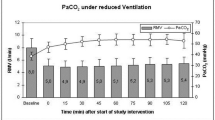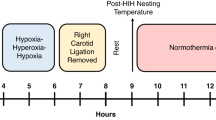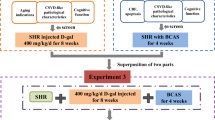Abstract
To ascertain the effect of extreme hypercapnia on perinatal hypoxic-ischemic brain damage, 7-d-postnatal rats were exposed to unilateral common carotid artery occlusion followed by hypoxia with 8% oxygen combined with 3, 12, or 15% carbon dioxide (CO2) for 2 h at 37°C. Survivors underwent neuropathologic examination at 30 d of postnatal age, and their brains were characterized as follows: 0 = normal; 1 = mild atrophy; 2 = moderate atrophy; 3 = cystic infarct with external dimensions <3 mm; and 4 = cystic infarct with external dimensions >3 mm. The width of the cerebral hemisphere ipsilateral to the carotid artery occlusion also was determined on a posterior coronal section and compared with that of the contralateral hemisphere to ascertain the severity of cerebral atrophy/cavitation. CO2 tensions averaged 5.08, 11.1, and 13.2 kPa in the 3, 12, and 15% CO2-exposed animals, respectively, during hypoxia-ischemia (HI). Neuropathologic results showed that immature rats exposed to 3 and 12% CO2 had similar severities of brain damage. In contrast, rat pups exposed to HI combined with 15% CO2 were significantly more brain damaged than littermates exposed to 3% CO2. Specifically, eight of 14 animals exposed to 15% CO2 showed cystic infarcts (grades 3 and 4), whereas none of 14 littermates exposed to 3% CO2 developed cystic infarcts (p < 0.01). Analyses of coronal width ratios at each CO2 exposure provided results comparable with those of the gross neuropathology scores. Cerebral blood flow (CBF), measured at 90 min of HI, was lowest in those immature rats exposed to 15% CO2 compared with control (p = 0.04), with higher values in those rat pups exposed to 3 and 12% CO2. The findings indicate that 7-d-postnatal rats exposed to HI with superimposed 12% CO2 are neither less nor more brain damaged than littermates exposed to 3% CO2 (normocapnia). In contrast, animals exposed to 15% CO2 are the most brain damaged of the three groups. Presumably, extreme hypercapnia produces more severe cardiovascular depression than is seen in animals subjected to lesser degrees of hypercapnia; the cardiovascular depression, in turn, leads to greater cerebral ischemia and ultimate brain damage.
Similar content being viewed by others
Log in or create a free account to read this content
Gain free access to this article, as well as selected content from this journal and more on nature.com
or
Abbreviations
- CBF:
-
cerebral blood flow
- HI:
-
hypoxia-ischemia
References
Vannucci RC, Towfighi J, Heitjan DF, Brucklacher RM 1995 Carbon dioxide protects the perinatal brain from hypoxic-ischemic damage: an experimental study in the immature rat. Pediatrics 95: 868–874
Greisen G, Munch H, Lou H 1987 Severe hypocarbia in preterm infants and neurodevelopmental deficit. Acta Pediatr Scand 86: 401–404
Graziani L, Spitzer AR, Mitchell DG, Merton DA, Stanley C, Robinson N, McKee L 1992 Mechanical ventilation in preterm infants: neurosonographic and developmental studies. Pediatrics 90: 515–522
Ikonen RS, Janas MO, Koidikko MJ, Laippala P, Kuusinen EJ 1992 Hyperbilirubinemia, hypocarbia and periventricular leukomalacia in preterm infants. Relationship to cerebral palsy. Acta Pediatr 81: 802–807
Rice JE, Vannucci RC, Brierley JB 1981 The influence of immaturity on hypoxic-ischemic brain damage in the rat. Ann Neurol 9: 131–141
Towfighi J, Yager JY, Housman C, Vannucci RC 1991 Neuropathology of remote hypoxic-ischemic damage in the immature rat. Acta Neuropathol 81: 578–587
Towfighi J, Housman C, Vannucci RC, Heitjan DF 1994 Effect of unilateral perinatal hypoxic-ischemic brain damage on the gross development of the opposite cerebral hemisphere. Biol Neonate 65: 108–118
Vannucci RC, Brucklacher RM, Vannucci SJ 1996 The effect of hyperglycemia on cerebral metabolism during hypoxia-ischemia in the immature rat. J Cereb Blood Flow Metab 16: 1026–1033
Vannucci RC, Duffy TE 1974 The influence of birth on carbohydrate and energy metabolism in rat brain. Am J Physiol 226: 933–940
Ringel M, Bryan RM, Vannucci RC 1991 Regional cerebral blood flow during hypoxia-ischemia in the immature rat: comparison of iodoantipyrine and iodoamphetamine as radioactive tracers. Dev Brain Res 59: 231–235
Lyons DT, Vasta F, Vannucci RC 1987 Autoradiographic determination of regional cerebral blood flow in the immature rat. Pediatr Res 21: 471–476
Vannucci RC, Brucklacher RM, Vannucci SJ 1997 Effect of carbon dioxide on cerebral metabolism during hypoxia-ischemia in the immature rat. Pediatr Res 42: 24–29
Mariani G, Cifuentes J, Carlo WA 1999 Randomized trial of permissive hypercapnia in preterm infants. Pediatrics 104: 1082–1088
Van den Berg PP, Nelen WLDM, Jongsma HW, Nijland R, Kollee LAA, Nijhuis JG, Eskes TKAB 1996 Neonatal complications in newborns with an umbilical artery pH <7.00. Am J Obstet Gynecol 175: 1152–1157
Goodwin TM, Belai I, Hernandez P, Durand M, Paul RH 1992 Asphyxial complications in the term newborn with severe umbilical acidemia. Am J Obstet Gynecol 162: 1506–1512
Low JA, Panagiotopoulos C, Derrick EJ 1994 Newborn complications after intrapartum asphyxia with metabolic acidosis in the term fetus. Am J Obstet Gynecol 170: 1081–1087
Low JA, Panagiotopoulos C, Derrick EJ 1995 Newborn complications after intrapartum asphyxia with metabolic acidosis in the preterm fetus. Am J Obstet Gynecol 172: 805–810
Author information
Authors and Affiliations
Corresponding author
Additional information
Supported by Program Project HD-30704 from The National Institute of Child Health and Human Development.
Rights and permissions
About this article
Cite this article
Vannucci, R., Towfighi, J., Brucklacher, R. et al. Effect of Extreme Hypercapnia on Hypoxic-Ischemic Brain Damage in the Immature Rat. Pediatr Res 49, 799–803 (2001). https://doi.org/10.1203/00006450-200106000-00015
Received:
Accepted:
Issue date:
DOI: https://doi.org/10.1203/00006450-200106000-00015
This article is cited by
-
Does prolonged severe hypercapnia interfere with normal cerebrovascular function in piglets?
Pediatric Research (2018)
-
Comparison of the effects of moderate and severe hypercapnic acidosis on ventilation-induced lung injury
BMC Anesthesiology (2015)
-
Na+/H+ Exchangers and Intracellular pH in Perinatal Brain Injury
Translational Stroke Research (2014)



